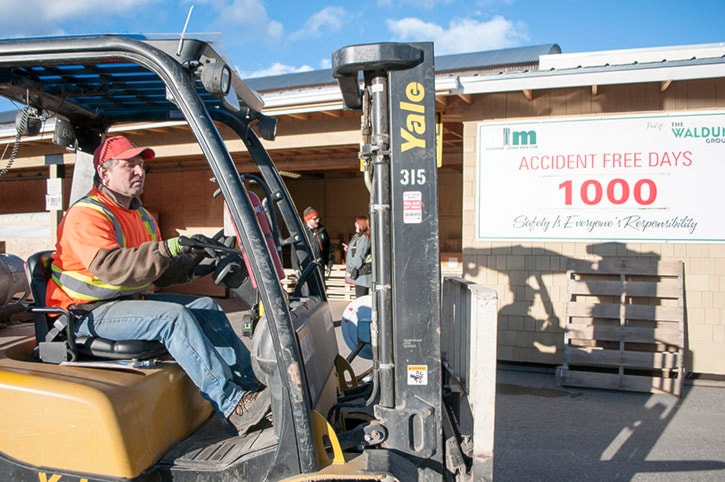Workplace safety, it seems, isn’t just good practice, it’s good business too.
That’s what Outdoor Living Manufacturing has found since they implemented a thorough safety program at their Penticton plant on Fairview Road.
From a low point a few years ago, the small value-added manufacturer is now shipping 6,000 to 7,000 units of their kits for backyard gazebos, pergolas, sheds and more to U.S and Canadian markets each year.
According to co-owner Greg Bailey, the company is seeing about 25 per cent growth, year over year.
But it’s not solid sales they want to talk about. Rather, it’s the safety program that has brought them to a milestone of 1,000 days of operation without a safety incident.
“Nothing comes before safety,” said Kirk Nagy, also a co-owner. “I don’t want to have somebody lose part of their enjoyment in life because they were working for us.”
Outdoor Living, which was started by Tom Turner, is now part of the Walden group of companies, one of the larger cedar shake and shingle producers, who decided to invest in the value-added sector some years ago.
“We never made money here at this plant. We were thinking of shutting the business down,” said Bailey, adding that a big problem had been finding and retaining workers, one shared by many Okanagan manufacturers.
“The reason I keep coming back to safety is believe it or not, I think we can credit some of our success to the structure our company developed when we decided to implement such a stringent safety program,” said Grant Daum, operations manager at the plant.
Nagy said they have seen a culture shift at OLM since implementing the safety program.
“It is, in the long run, better business. You are more efficient, you have higher quality controls when you are a safe company,” said Nagy, adding that he saw it as both a moral responsibility and good business ethics.
An accident where an employee lose a thumb in a saw accident proved to be the tipping point for the owners, who were already questioning the future of OLM after dealing with financial losses.
“If Grant was finding it too difficult to implement a proper safety program, we were prepared to shut the plant down,” said Bailey.
Now, the plant has seen a culture change, with the employees taking ownership of the safety program and looking out for each other.
“It’s not an act we put on,” said Nagy. “A thousand days doing what we do (without an accident) is phenomenal.”
They will point out things, even things done by management,” said Nagy, who remembers trying to walk through the yard without a safety vest and having employees point out the safety concern.
“That’s how you know the culture is changing when they are supporting it themselves.”
While the safety plan may have been implemented by management, Daum said the credit goes to the workers for embracing it, including their office manager, Val Broeckx, who took on the role of safety co-ordinator, and has recently finished a course to become an internal safety auditor.
“It gives everyone a sense of self-worth within the program, and if you can extrapolate that over your production programs, it really helps,” said Bailey. “Kirk used the term family. They all have a place in the safety program.”
Bailey admits the safety program is expensive, but has proved to be good value.
“Having the safety procedures and having the crew buy in … led to unexpected gains on the production side of things.”
Daum said the stringent safety program helped create uniformity and structure in the plant.
“I noticed it quite quickly developed a line of structure within our plant that was badly needed,” said Daum. “It was easier for us to build on that structure; to have production controls, to have production standards.”
To put some numbers to that claim, Bailey said that the plant now produces double the product, at a higher quality level, than they were doing before the changes. Staff-wise, they find it is easier to retain employees or rehire after a layoff period.
“They know that we are keeping them safe. Those employees, they want to keep coming back. We are hiring the same people, that know our program,” said Broeckx.
